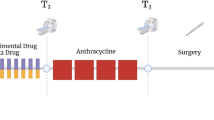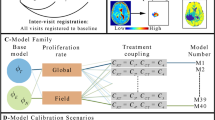Abstract
Cell invasion, motility, and proliferation level estimate (CIMPLE) mapping is a new imaging technique that provides parametric maps of microscopic invasion and proliferation rate estimates using serial diffusion MRI data. However, a few practical constraints have limited the use of CIMPLE maps as a tool for estimating these dynamic parameters, particularly during short-interval follow-up times. The purpose of the current study was to develop an approximation for the CIMPLE map solution for short-interval scanning involving the assumption that net intervoxel tumor invasion does not occur within sufficiently short time frames. Proliferation rate maps created using the “no invasion” approximation were found to be increasingly similar to maps created from full solution during increasingly longer follow-up intervals (3D cross correlation, R 2 = 0.5298, P = 0.0001). Results also indicate proliferation rate maps from the “no invasion” approximation had significantly higher sensitivity (82 vs. 64 %) and specificity (90 vs. 80 %) for predicting 6 month progression free survival and was a better predictor of time to progression during standard radiochemotherapy compared to the full CIMPLE solution (log-rank; no invasion estimation, P = 0.0134; full solution, P = 0.0555). Together, results suggest the “no invasion” approximation allows for quick estimation of proliferation rate using diffusion MRI data obtained from multiple scans obtained daily or biweekly for use in quantifying early treatment response.





Similar content being viewed by others
References
Padhani AR, Liu G, Mu-Koh D, Chenevert TL, Thoeny HC, Takahara T, Dzik-Jurasz A, Ross BD, Van Cauteren M, Collins D, Hammoud DA, Rustin GJS, Taouli B, Choyke PL (2009) Diffusion-weighted magnetic resonance imaging as a cancer biomarker: consensus and recommendations. Neoplasia 11:102–125
Chenevert TL, McKeever PE, Ross BD (1997) Monitoring early response of experimental brain tumors to therapy using diffusion magnetic resonance imaging. Clin Cancer Res 3:1457–1466
Provenzale JM, Mukundan S, Barboriak DP (2006) Diffusion-weighted and perfusion MR imaging for brain tumor characterization and assessment of treatment response. Radiology 239:632–649
Sugahara T, Korogi Y, Kochi M, Ikushima I, Shigematu Y, Hirai T, Okuda T, Liang L, Ge Y, Komohara Y, Ushio Y, Takahashi M (1999) Usefulness of diffusion-weighted MRI with echo-planar technique in the evaluation of cellularity in gliomas. J Magn Reson Imaging 9:53–60
Chenevert TL, Stegman LD, Taylor JM, Robertson PL, Greenberg HS, Rehemtulla A, Ross BD (2000) Diffusion magnetic resonance imaging: an early surrogate marker of therapeutic efficacy in brain tumors. J Natl Cancer Inst 92:2029–2036
Lyng H, Haraldseth O, Rofstad EK (2000) Measurements of cell density and necrotic fraction in human melanoma xenografts by diffusion weighted magnetic resonance imaging. Magn Reson Med 43:828–836
Hayashida Y, Hirai T, Morishita S, Kitajima M, Murakami R, Korogi Y, Makino K, Nakamura H, Ikushima I, Yamura M, Kochi M, Kuratsu JI, Yamashita Y (2006) Diffusion-weighted imaging of metastatic brain tumors: comparison with histologic type and tumor cellularity. AJNR Am J Neuroradiol 27:1419–1425
Manenti G, Di Roma M, Mancino S, Bartolucci DA, Palmieri G, Mastrangeli R, Miano R, Squillaci E, Simonetti G (2008) Malignant renal neoplasms: correlation between ADC values and cellularity in diffusion weighted magnetic resonance imaging at 3 T. Radiol Med 113:199–213
Gauvain KM, McKinstry RC, Mukherjee P, Perry A, Neil JJ, Kaufman BA, Hayashi RJ (2001) Evaluating pediatric brain tumor cellularity with diffusion-tensor imaging. AJR Am J Roentgenol 177:449–454
Kinoshita M, Hashimoto N, Goto T, Kagawa N, Kishima H, Izumoto S, Tanaka H, Fujita N, Yoshimine T (2008) Fractional anisotropy and tumor cell density of the tumor core show positive correlation in diffusion tensor magnetic resonance imaging of malignant brain tumors. Neuroimage 43:29–35
Kono K, Inoue Y, Nakayama K, Shakudo M, Morino M, Ohata K, Wakasa K, Yamada R (2001) The role of diffusion-weighted imaging in patients with brain tumors. AJNR Am J Neuroradiol 22:1081–1088
Stegman LD, Rehemtulla A, Hamstra DA, Rice DJ, Jonas SJ, Stout KL, Chenevert TL, Ross BD (2000) Diffusion MRI detects early events in the response of a glioma model to the yeast cytosine deaminase gene therapy strategy. Gene Ther 7:1005–1010
Ellingson BM, Rand SD, Malkin MG, Prost R, Connelly JM, LaViolette PS, Bedekar DP, Schmainda KM (2010) Spatially quantifying microscopic tumor invasion and proliferation using a voxel-wise analytical solution to a glioma growth model and serial diffusion MRI. Proc Int Soc Magn Reson Med 18:612
Ellingson BM, LaViolette PS, Rand SD, Malkin MG, Connelly JM, Mueller WM, Prost RW, Schmainda KM (2011) Spatially quantifying microscopic tumor invasion and proliferation using a voxel-wise solution to a glioma growth model and serial diffusion MRI. Magn Reson Med 65:1132–1144
Ellingson BM, Cloughesy TF, Lai A, Nghiemphu PL, Pope WB (2011) Cell invasion, motility, and proliferation level estimate (CIMPLE) maps derived from serial diffusion MR images in recurrent glioblastoma treated with bevacizumab. J Neurooncol 105:91–101
Swanson KR, Alvord EC Jr, Murray JD (2000) A quantitative model for differential motility of gliomas in grey and white matter. Cell Prolif 33:317–329
Harpold HL, Alvord EC Jr, Swanson KR Jr (2007) The evolution of mathematical modeling of glioma proliferation and invasion. J Neuropathol Exp Neurol 66:1–9
Farlow SJ (1993) Partial differential equations for scientists and engineers. Wiley, New York
Reese TG, Heid O, Weisskoff RM, Wedeen VJ (2003) Reduction of eddy-current-induced distortion in diffusion MRI using a twice-refocused spin echo. Magn Reson Med 49:177–182
Cox RW, Jesmanowicz A (1999) Real-time 3D image registration for functional MRI. Magn Reson Med 42:1014–1018
Acknowledgments
NIH/NCI R21CA167354 (BME); UCLA Institute for Molecular Medicine Seed Grant (BME); UCLA Radiology Exploratory Research Grant (BME); University of California Cancer Research Coordinating Committee Grant (BME); ACRIN Young Investigator Initiative Grant (BME); Art of the Brain (TFC); Ziering Family Foundation in memory of Sigi Ziering (TFC); Singleton Family Foundation (TFC); Clarence Klein Fund for Neuro-Oncology (TFC).
Author information
Authors and Affiliations
Corresponding author
Rights and permissions
About this article
Cite this article
Zaw, T.M., Pope, W.B., Cloughesy, T.F. et al. Short-interval estimation of proliferation rate using serial diffusion MRI predicts progression-free survival in newly diagnosed glioblastoma treated with radiochemotherapy. J Neurooncol 116, 601–608 (2014). https://doi.org/10.1007/s11060-013-1344-7
Received:
Accepted:
Published:
Issue Date:
DOI: https://doi.org/10.1007/s11060-013-1344-7




